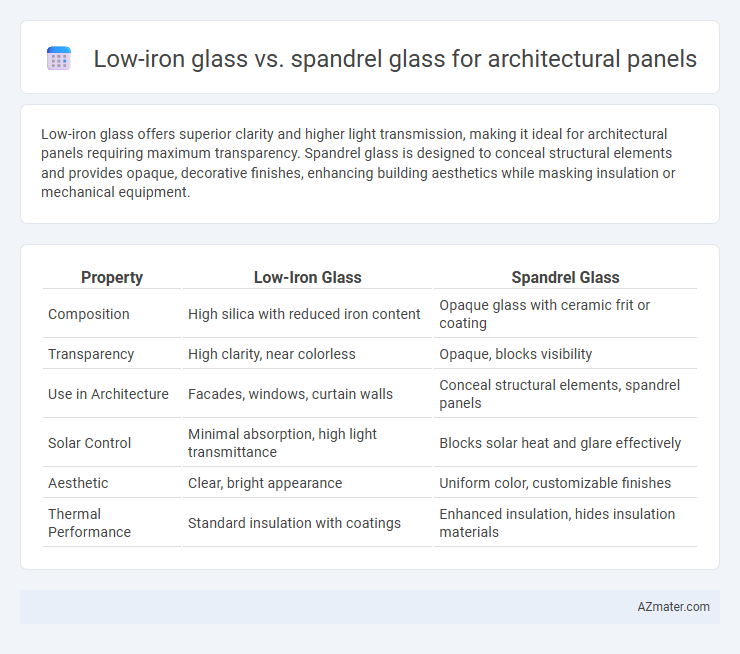Low-iron glass offers superior clarity and higher light transmission, making it ideal for architectural panels requiring maximum transparency. Spandrel glass is designed to conceal structural elements and provides opaque, decorative finishes, enhancing building aesthetics while masking insulation or mechanical equipment.
Table of Comparison
| Property | Low-Iron Glass | Spandrel Glass |
|---|---|---|
| Composition | High silica with reduced iron content | Opaque glass with ceramic frit or coating |
| Transparency | High clarity, near colorless | Opaque, blocks visibility |
| Use in Architecture | Facades, windows, curtain walls | Conceal structural elements, spandrel panels |
| Solar Control | Minimal absorption, high light transmittance | Blocks solar heat and glare effectively |
| Aesthetic | Clear, bright appearance | Uniform color, customizable finishes |
| Thermal Performance | Standard insulation with coatings | Enhanced insulation, hides insulation materials |
Understanding Low-Iron Glass in Architecture
Low-iron glass, known for its high transparency and minimal green tint, enhances natural light transmission in architectural panels, making it ideal for facades and curtain walls demanding clarity and visual purity. Compared to spandrel glass, which is used to conceal structural elements with an opaque finish, low-iron glass prioritizes aesthetics by maximizing daylight and offering a true color rendering that complements modern design. Its composition with reduced iron content results in a clearer, more brilliant glass that elevates building appearance while supporting energy efficiency goals through superior light diffusion.
What is Spandrel Glass? Key Features and Uses
Spandrel glass is an opaque or translucent architectural panel designed to conceal structural elements, insulation, and mechanical components in curtain wall systems. Key features include customizable color and texture, thermal insulation, and glare reduction, enhancing building aesthetics while maintaining energy efficiency. Commonly used in high-rise buildings, spandrel glass integrates seamlessly with vision glass to create uniform facades and protect non-vision areas from weather exposure.
Optical Clarity: Low-Iron Glass Advantages
Low-iron glass offers superior optical clarity compared to spandrel glass due to its reduced iron content, which minimizes the greenish tint commonly found in standard glass. This enhanced transparency allows for more natural light transmission and true color representation, making it ideal for architectural panels requiring high visual quality. In contrast, spandrel glass typically includes coatings or treatments that reduce clarity to conceal structural elements, resulting in less light transmission and muted appearance.
Aesthetic Considerations: Comparing Visual Qualities
Low-iron glass offers superior clarity and a true color representation, making it ideal for architectural panels requiring a pristine, transparent look with minimal green tint. Spandrel glass, often opaque or frosted, provides consistent color matching and conceals structural elements, enhancing the uniformity and sleekness of building facades. Choosing between low-iron and spandrel glass depends on desired transparency levels and whether the design prioritizes natural light transmission or visual masking of behind-the-panel components.
Performance Factors: Thermal and Structural Properties
Low-iron glass offers superior clarity and enhanced light transmission, making it ideal for architectural panels requiring high visibility and natural illumination, while its thermal performance includes moderate insulation properties that can be improved with coatings. Spandrel glass, commonly used to conceal structural components, typically incorporates thermal insulation materials or reflective coatings, enhancing energy efficiency and reducing heat transfer through building envelopes. Structurally, low-iron glass maintains comparable strength and durability to standard glass but lacks the opaque characteristics of spandrel glass, which provides additional rigidity and integration for facade systems.
Color Consistency and Light Transmission
Low-iron glass offers superior light transmission with a clarity level of up to 91%, ensuring vibrant and true-to-life color rendering in architectural panels. Spandrel glass, typically coated or back-painted, provides consistent color appearance but drastically reduces visible light transmission to about 10-20%, primarily used to mask structural components. For projects emphasizing color consistency across facades with high natural light flow, low-iron glass is optimal, while spandrel glass is preferred for opaque sections requiring uniform exterior aesthetics.
Cost Comparison: Low-Iron vs Spandrel Glass
Low-iron glass typically costs 30-50% more than standard spandrel glass due to its higher clarity and purity, making it ideal for applications where transparency is crucial. Spandrel glass, often used to conceal building elements, is more affordable and widely preferred for budget-conscious architectural panels. Choosing between low-iron and spandrel glass depends on the balance between desired aesthetic quality and cost efficiency in construction projects.
Applications in Modern Building Facades
Low-iron glass offers superior clarity and light transmission, making it ideal for architectural panels where natural daylight and visibility are priorities, such as curtain walls and storefronts. Spandrel glass, with its opaque or translucent properties, is designed to conceal structural elements, insulation, or mechanical equipment in building facades, often used in combination with vision glass for seamless exterior aesthetics. Modern building facades frequently integrate both materials to balance transparency and concealment, enhancing energy efficiency and visual uniformity.
Sustainability and Environmental Impact
Low-iron glass offers superior clarity and natural light transmission, reducing the need for artificial lighting and lowering energy consumption in buildings. Spandrel glass, typically coated or back-painted, allows for the concealment of structural elements while providing thermal insulation that helps minimize heat gain and loss, contributing to energy efficiency. Both materials support sustainable architecture by enhancing daylight utilization and thermal performance, but low-iron glass has a lower environmental impact due to its minimal additives and recyclability.
Choosing the Right Glass for Architectural Panels
Low-iron glass offers superior clarity and natural light transmission, making it ideal for architectural panels requiring maximum transparency and color accuracy. Spandrel glass, with its opaque or coated finish, effectively conceals structural elements and insulation, enhancing aesthetic uniformity in building facades. Selecting the right glass depends on balancing transparency needs with design requirements, where low-iron glass suits facades showcasing interiors and spandrel glass is preferred for masking non-visual areas.

Infographic: Low-iron glass vs Spandrel glass for Architectural panel
 azmater.com
azmater.com